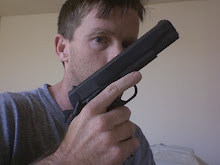A couple of weeks ago, the GeekWithA.45 ruminated at length on his backup gun, a Smith & Wesson 642 LS .38 Special, with a 2-inch barrel. Long and short of it, he felt like he was leaving some performance on the table by not having the option of loading the gun with .357 Magnum. After he'd done a little research, he found this, at speer-bullets.com:
.38 Special +P, 135 gr.: 860 ft/sec
.357 Magnum, 135 gr.: 990 ft/sec
Now, your typical .357 Mag cartridge, at that weight (125-135 gr.) is loaded to about 1450 ft/sec, measured out of a 4-inch barrel, one of the fastest defensive sidearm cartridges out there. .38 Special, not so fast. Normal load is about 850 ft/ sec for the same weight, around 945 ft/sec for +P. Now, it looked like not a whole lot of advantage was gained by being able to load .357 Magnum. (Incidentally, the Geek later found out the loads he was looking at were underpowered.)
Now here's where my interest in that particular topic comes in. I have a Ruger SP101, with the 2.25-inch barrel. My typical outing with it consists of a box of .38 Special, and a box of .357 Magnum. .38 Special ain't so bad, but after the box of .357 Mag, I have this nagging pain in my wrist for a bit. And while I am shooting, yeah, it hurts. You have to have a death grip and a half on that thing or you're gonna end up shooting a bird out of a tree! Yes, that was hyperbole, but that little SP101 does indeed have a ferocious kick to it when it's loaded with .357 Magnum. And I would hate to think that I was dealing with that kick and that LOUD BANG! and getting jack in return. So off I went to Google and went looking for some ballistics data for the SP101. And here's what I found...
.357 Magnum, 135 gr.: 990 ft/sec
Now, your typical .357 Mag cartridge, at that weight (125-135 gr.) is loaded to about 1450 ft/sec, measured out of a 4-inch barrel, one of the fastest defensive sidearm cartridges out there. .38 Special, not so fast. Normal load is about 850 ft/ sec for the same weight, around 945 ft/sec for +P. Now, it looked like not a whole lot of advantage was gained by being able to load .357 Magnum. (Incidentally, the Geek later found out the loads he was looking at were underpowered.)
Now here's where my interest in that particular topic comes in. I have a Ruger SP101, with the 2.25-inch barrel. My typical outing with it consists of a box of .38 Special, and a box of .357 Magnum. .38 Special ain't so bad, but after the box of .357 Mag, I have this nagging pain in my wrist for a bit. And while I am shooting, yeah, it hurts. You have to have a death grip and a half on that thing or you're gonna end up shooting a bird out of a tree! Yes, that was hyperbole, but that little SP101 does indeed have a ferocious kick to it when it's loaded with .357 Magnum. And I would hate to think that I was dealing with that kick and that LOUD BANG! and getting jack in return. So off I went to Google and went looking for some ballistics data for the SP101. And here's what I found...
...the Remington 125-grain jacketed hollow point...actually did pretty well in the 2-inch Ruger, reaching an impressive 1,357 feet per second.
Now, considering the Remington 125-grain JHP is loaded to 1,450 ft/sec, that's pretty good out of that little 2-inch barrel. (The link escapes me, but I could have sworn I saw this same load chronographed out of the 2.25" barrel at 1,378 ft/sec.) You still end up with about 90% of the energy the .357 imparts on whatever it hits at its rated velocity...assuming, of course, you're not more than a few feet away from your intended target. Which I'd really like to be, due to the aforementioned kick. I do indeed feel better now...just keep me away from the Ruger Super Redhawk, in .480 Ruger with the 2.5" barrel...


|